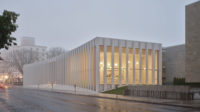Praxis is building a new city. Or, at least, that’s what the company’s website proclaims, in text overlaying an aerial rendering of ivory buildings tucked into the lush greenery of a coastal strip. Launched in winter 2021 by tech-adjacent businessmen Dryden Brown and Charlie Callinan, both in their mid-20s, Praxis calls itself “a grassroots movement of modern pioneers” and aims to build an autonomous cryptocurrency-backed city “somewhere in the Mediterranean” by 2050.
The figure of the architect is noticeably absent from Praxis’s master plan. In 2023, the company announced the city’s design was to be overseen by Zaha Hadid Architects (ZHA)—no surprise, as the vision of Praxis gels with the anti-regulatory, tech-forward political leanings of firm leader Patrik Schumacher—but the firm’s name is nowhere to be found on the Praxis website, and ZHA did not respond to RECORD’s request for comment regarding its involvement. No matter, as the Praxis model of city-building is based on a “demand-first” and bottom-up approach, which will see the aesthetic and functional vision of the city formed by a community of future citizens.
I started following the progress of Praxis soon after it launched: its website was bare-bones and motives shrouded, but its channel on the social media platform Discord was bustling as a place for hopeful Praxians to discuss what their future city would look like. Images of stately neoclassical architecture dominated the “#aesthetics” thread, along with a smattering of AI-generated renderings of hyper-futuristic buildings, as well as lifestyle-inspiration images of armored centurions, with busty women depicted in servile or domestic roles. The company now hosts real-life parties and gatherings in addition to its Discord channel (now some 12,000 members strong), sporadically publishes essays on its website, and produces a podcast interview series called The Frontier. While it has not secured a physical site on which to build, applications are now open for a “Steel Visa,” which grants a Praxis proto-citizenship card for agreeing to a future deposit of $5,000, and the company recently unveiled the PRAX credit system, which will measure an individual’s contributions to building the city.
Praxis’s success is far from assured, but, operating as a tech start-up, the company has raised over $20 million in funding, largely by courting the libertarian sector of the tech world—which, having exhausted Silicon Valley’s territorial limits, has become eager to fund extra-urban ventures out of government-regulation reach. And, in June, Praxis announced the hiring of megadeveloper David Weinreb, the former CEO of the Howard Hughes Corporation, who has overseen several master-planned luxury neighborhoods across the country, including Ward Village in Honolulu and The Woodlands in Texas.
Such collaborators suggest that, despite its hyperbolic ambitions, the Praxis initiative represents a natural continuation and acceleration of the spatial “splintering” that marks the current trajectory of urban development. A product of political and economic forces that favor privatism and profit, the contemporary city is “an archipelago of enclaves,” a term coined by geographers Stephen Graham and Simon Marvin to describe a collection of bounded, internally organized sites that consolidates all elements of urban life within their borders. This fragmentary model opposes itself to the Modernist vision of city-building—best represented by Le Corbusier’s unrealized Radiant City—a top-down organization that rationally orders elements of urban life into a cohesive whole.
Hudson Yards, that city within a city on Manhattan’s West Side, exemplifies the current tendency toward spatial expressions of privatism. Praxis, yet more extreme, closes the circle of history, bringing the exclusionary enclave back out toward new territories. But, whereas Hudson Yards—along with such concurrent city-building initiatives as Saudi Arabia’s The Line—though gilded with idealistic claims of maximizing sustainability and “innovation” is conceived primarily for economic benefit, Praxis presents itself as an ideological venture, with a stated mission of “[accelerating] technological progress to create a vital future for humanity.”
In its short lifespan, Praxis’s initially cryptic ideology has crystallized. In a transcript acquired by The New York Times, Brown told his speechwriter that the inspiration for Praxis came during the summer of 2020, when, sequestered in his West Village apartment, he was disturbed and frightened by reports of looting in Manhattan. In writings published on the Praxis website by community members and company leaders, the state of the contemporary city is bemoaned as unhygienic, rampant with crime and disorder, and spiritually bereft.
This is a familiar story, the same strain of anti-urbanism that has driven the privileged out of cities since the late 19th century, first to pastoral retreats following the industrial revolution, and then to newly accessible suburbs after World War II. In recent years, it has re-emerged as a political talking point; last year, Donald Trump went so far as to propose something straight out of the Praxis playbook: to build ten “Freedom Cities” on federal land “to reopen the frontier, reignite American imagination, and give hundreds of thousands of young people . . . a new shot at the American dream.”
Despite its radical posturing, the philosophy propelling Praxis’s desired exodus aligns with these long-held gripes about the sicknesses of the modern world, from the erosion of the family unit and traditional gender roles to the rise of secularism and moral relativism and the perceived fact that mainstream culture “rejects beauty” (an aesthetic critique covering both contemporary architecture and women’s fashion). Against this image of societal decline, Praxis insists on a return to the vague but foundational values of “vitality,” “nobility,” and “virtue,” associated with the wisdom of Greco-Roman antiquity and preindustrial serenity. “We’ve lost the future because we’ve lost the past. We live in an atomized society. We bowl alone and demonize our compatriots together,” wrote Brown in a 2020 essay published on the Praxis website.
This reactionary political foundation is in some ways at odds with Praxis’s tech-forward posture, but technological “accelerationism” is nonetheless key to the Praxis social vision. This conflict is reflected in the company’s sparse architectural imaginings and helps explain why it adulates both Classical form and the futuristic curves of parametricism. Modernist architecture, however, is notably absent from Praxian aesthetic visions—ironically so, as the entire endeavor signals a return to the utopian impulse that defined the pursuit of architecture in the early 20th century. The rigid tabula rasa urban visions dreamed up by Modernists—such as the Radiant City, or Frank Lloyd Wright’s Broadacre City—were long ago discarded in recognition of the complexities of real urban space.
Praxis’s ideological motivation marries a Modernist faith in technology and ambition to build a new world to a profound nostalgia. Whereas Modernists abandoned the past, destroying history in their pursuit of ideal futures, Praxis rejects the present, blindly assigning to the past an inherent moral truth that they see as lost.
Urban form has long been inextricably tied to utopian thought, and Praxis is not the first city-building scheme to dream of leaving the existing world behind, but it does distinguish itself by leveraging the increasingly illogical operations of venture capitalism that subsidize the tech world and prop up extreme endeavors—all you need is a flashy pitch deck. While Praxis’s populist slant supposedly frees its imaginings from the hierarchy of expertise, it centers the tech entrepreneur as sole savior. In the process, it makes literal the metaphorical tropes that have explicitly or implicitly girded all kinds of urban change—the glorious frontier, intrepid pioneers, and sparkling new worlds.
The myth of the frontier, which has persisted in the American imagination long after the country became settled, requires the accompanying myth of virgin, unconquered territory, ripe for the taking. In the United States, of course, that was never a reality—even in the golden ages that Praxis continually references—and the hyperdeveloped state of the contemporary world makes it even more fantastical. In the case of The Line, the Saudi Arabian government’s breathless promises of a futuristic linear city rising out of the desert glossed over the fact that the land on which the city is being built has long been inhabited by people of the Howeitat tribe. When construction started last year, people were forcibly displaced and their homes destroyed to make room for the city; six Howeitat men now face execution or life imprisonment for resisting their eviction.
Though it looks unlikely that Praxis will consolidate the capital or level of political authority required to achieve a similar feat of spatial erasure on the Mediterranean coast, its naked ideological aims highlight the pitfalls of grandiose urban visions that promise salvation through territorial expansion. It’s certainly easier to dream up new cities, but we need not destroy the past or the present in pursuit of a brighter future; real and pressing work is needed in the existing places of our world.






Post a comment to this article
Report Abusive Comment